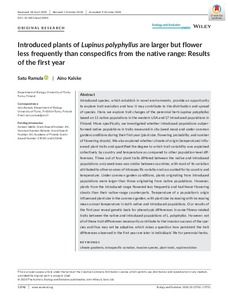| dc.contributor.author | Kalske A | |
| dc.contributor.author | Ramula S | |
| dc.date.accessioned | 2022-10-28T14:27:50Z | |
| dc.date.available | 2022-10-28T14:27:50Z | |
| dc.identifier.uri | https://www.utupub.fi/handle/10024/171511 | |
| dc.description.abstract | Introduced species, which establish in novel environments, provide an opportunity to explore trait evolution and how it may contribute to the distribution and spread of species. Here, we explore trait changes of the perennial herb Lupinus polyphyllus based on 11 native populations in the western USA and 17 introduced populations in Finland. More specifically, we investigated whether introduced populations outperformed native populations in traits measured in situ (seed mass) and under common garden conditions during their first year (plant size, flowering probability, and number of flowering shoots). We also explored whether climate of origin (temperature) influenced plant traits and quantified the degree to which trait variability was explained collectively by country and temperature as compared to other population-level differences. Three out of four plant traits differed between the native and introduced populations; only seed mass was similar between countries, with most of its variation attributed to other sources of intraspecific variation not accounted for by country and temperature. Under common garden conditions, plants originating from introduced populations were larger than those originating from native populations. However, plants from the introduced range flowered less frequently and had fewer flowering shoots than their native-range counterparts. Temperature of a population's origin influenced plant size in the common garden, with plant size increasing with increasing mean annual temperature in both native and introduced populations. Our results of the first year reveal genetic basis for phenotypic differences in some fitness-related traits between the native and introduced populations of L. polyphyllus. However, not all of these trait differences necessarily contribute to the invasion success of the species and thus may not be adaptive, which raises a question how persistent the trait differences observed in the first year are later in individuals' life for perennial herbs. | |
| dc.language.iso | en | |
| dc.publisher | WILEY | |
| dc.title | Introduced plants of Lupinus polyphyllus are larger but flower less frequently than conspecifics from the native range: Results of the first year | |
| dc.identifier.urn | URN:NBN:fi-fe2021042826674 | |
| dc.relation.volume | 10 | |
| dc.contributor.organization | fi=ekologia ja evoluutiobiologia|en=Ecology and Evolutionary Biology| | |
| dc.contributor.organization-code | 2606402 | |
| dc.converis.publication-id | 50722323 | |
| dc.converis.url | https://research.utu.fi/converis/portal/Publication/50722323 | |
| dc.format.pagerange | 13742 | |
| dc.format.pagerange | 13751 | |
| dc.identifier.eissn | 2045-7758 | |
| dc.identifier.jour-issn | 2045-7758 | |
| dc.okm.affiliatedauthor | Ramula, Satu | |
| dc.okm.affiliatedauthor | Kalske, Aino | |
| dc.okm.discipline | 1181 Ekologia, evoluutiobiologia | fi_FI |
| dc.okm.discipline | 1181 Ecology, evolutionary biology | en_GB |
| dc.okm.internationalcopublication | not an international co-publication | |
| dc.okm.internationality | International publication | |
| dc.okm.type | Journal article | |
| dc.publisher.country | Britannia | fi_FI |
| dc.publisher.country | United Kingdom | en_GB |
| dc.publisher.country-code | GB | |
| dc.relation.doi | 10.1002/ece3.6964 | |
| dc.relation.ispartofjournal | Ecology and Evolution | |
| dc.relation.issue | 24 | |
| dc.year.issued | 2020 | |
